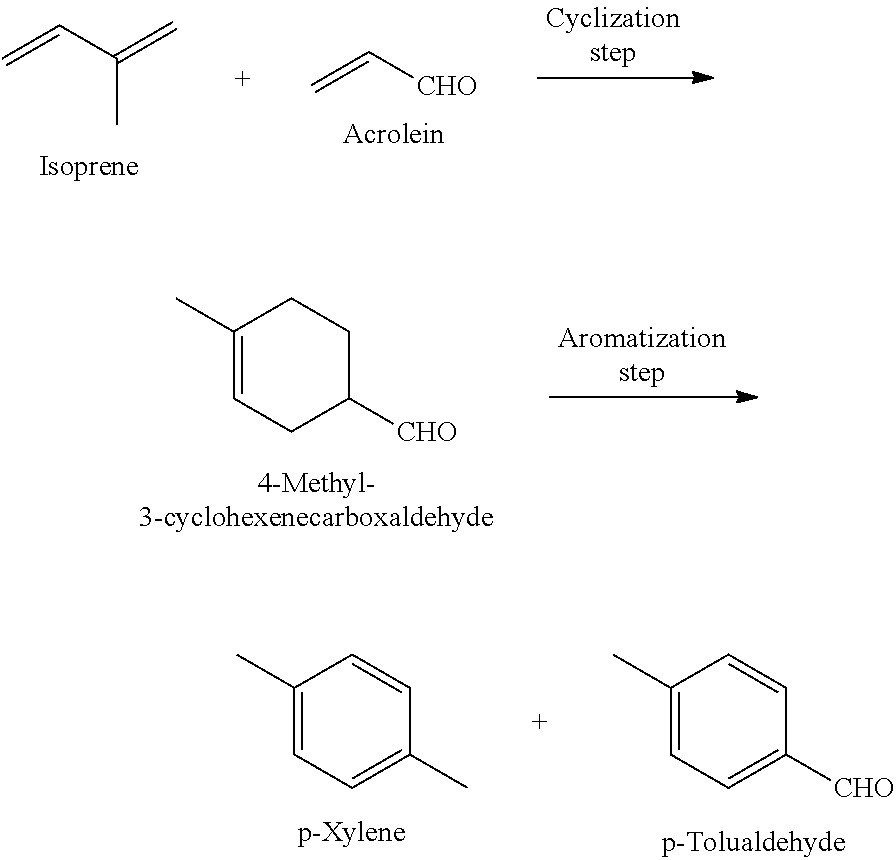Method for producing p-xylene and/or p-tolualdehyde
a technology of ptoluene and ptoluene, which is applied in the direction of physical/chemical process catalysts, bulk chemical production, metal/metal-oxide/metal-hydroxide catalysts, etc., can solve the problems of high production cost, high production cost, and high yield of p-xylene, and achieves a shorter process. , the effect of high yield
- Summary
- Abstract
- Description
- Claims
- Application Information
AI Technical Summary
Benefits of technology
Problems solved by technology
Method used
Image
Examples
example 1
Production of 4-Methyl-3-Cyclohexenecarboxaldehyde (Cyclization Step)
[0055]After replacing the atmosphere in a 25-mL evaporating flask with argon, a stirrer and aluminum chloride (530 mg) were placed therein, and the content was cooled to 0° C. and stirred. Tetrahydrofuran (0.64 mL) was added to the flask, and the resulting mixture was stirred at the same temperature for 15 minutes, followed by adding acrolein (13.4 mL) and isoprene (20 mL) thereto, and then stirring the mixture at 25° C. for 72 hours. After adding 1 mol / L aqueous sodium hydroxide solution (12 mL) to the mixture, extraction with chloroform was performed. The organic layer was filtered through Celite, and the obtained solution was concentrated with an evaporator to obtain a crude product of 4-methyl-3-cyclohexenecarboxaldehyde. This crude product was subjected to 1H-NMR analysis together with a known weight of ethanol (internal standard substance) to calculate the yield of 4-methyl-3-cyclohexenecarboxaldehyde (yield,...
reference example 1
Preparation of Chromium Oxide on Alumina (Catalyst A)
[0056]Chromium (III) nitrate nonahydrate (7.7 g) was dissolved in distilled water (25 mL), and alumina (JGC Catalysts and Chemicals Ltd., N613N) (19 g) was added to the resulting solution. The obtained suspension was stirred on a hot plate heated at 120° C. to evaporate water. The resulting solid was placed on an evaporating dish, and calcination was carried out at 500° C. for 4 hours to obtain Catalyst A.
reference example 2
Preparation of Chromium Oxide on Silica-alumina (Catalyst B)
[0057]Catalyst B was prepared by the same method as in Reference Example 1 except that silica-alumina (JGC Catalysts and Chemicals Ltd., N633HN; 66.5% silica, 25.1% alumina) (19 g) was used instead of alumina.
PUM
| Property | Measurement | Unit |
|---|---|---|
| reaction temperature | aaaaa | aaaaa |
| temperature | aaaaa | aaaaa |
| temperature | aaaaa | aaaaa |
Abstract
Description
Claims
Application Information
 Login to View More
Login to View More - R&D
- Intellectual Property
- Life Sciences
- Materials
- Tech Scout
- Unparalleled Data Quality
- Higher Quality Content
- 60% Fewer Hallucinations
Browse by: Latest US Patents, China's latest patents, Technical Efficacy Thesaurus, Application Domain, Technology Topic, Popular Technical Reports.
© 2025 PatSnap. All rights reserved.Legal|Privacy policy|Modern Slavery Act Transparency Statement|Sitemap|About US| Contact US: help@patsnap.com


